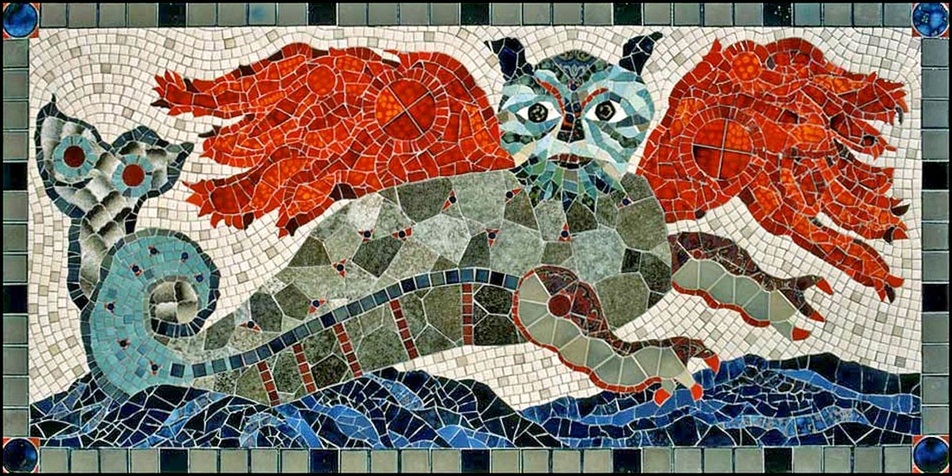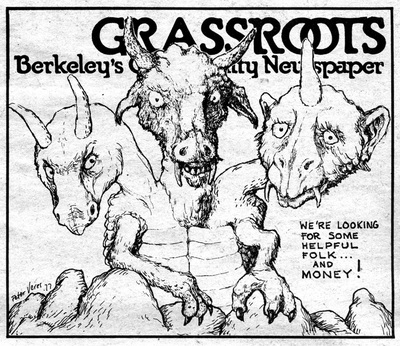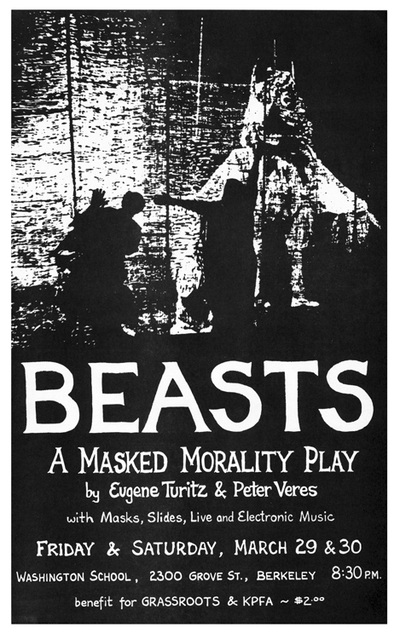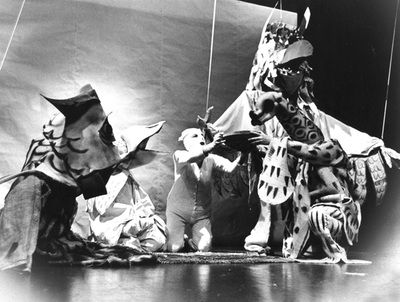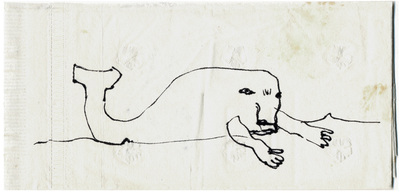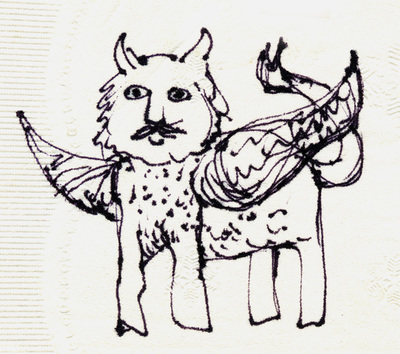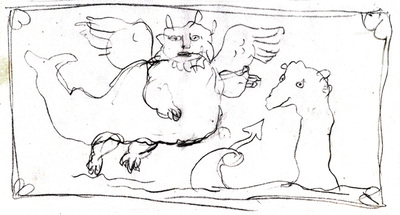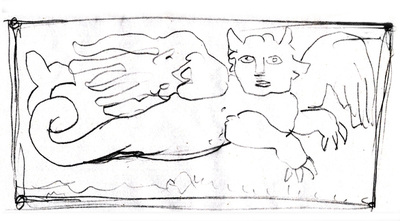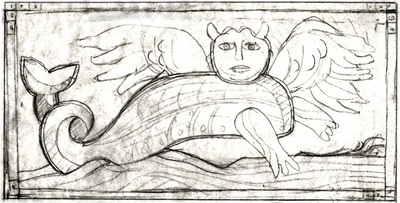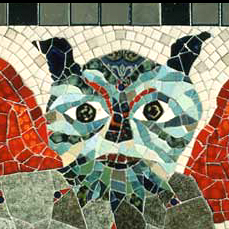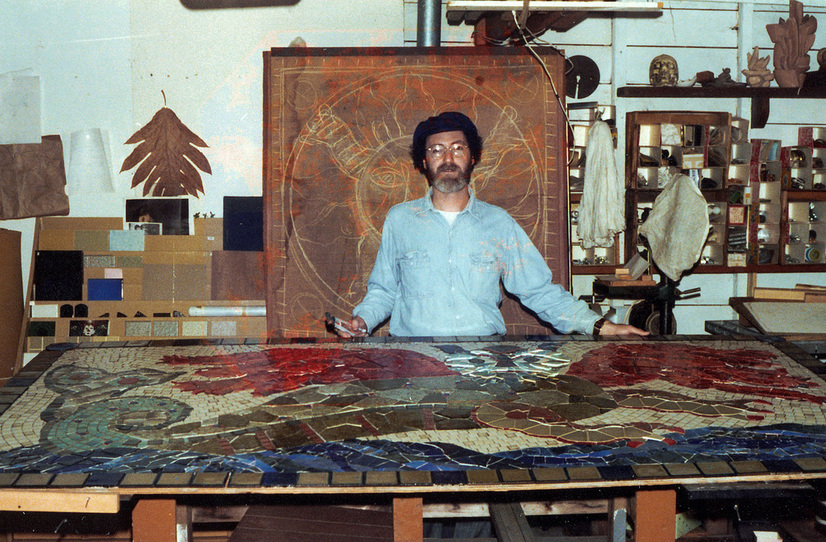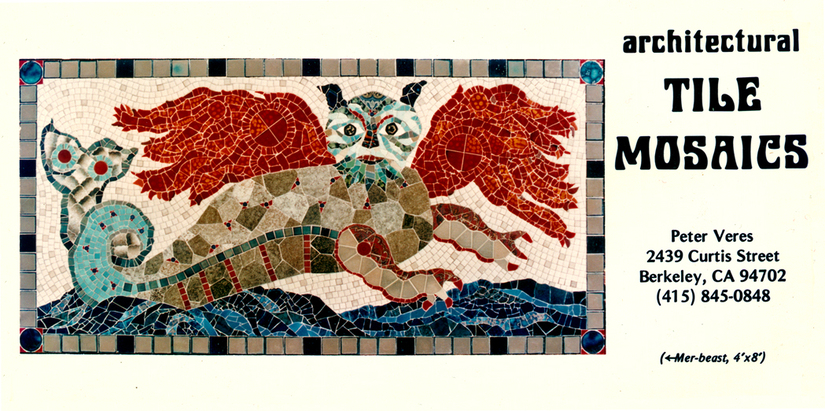MER-BEAST 1977
Mer-Beast 48" x 96"
Sometime in 1977 I learned of a competition run by the San Francisco Arts Commission for artworks to be installed in the newly constructed Terminal 3 of the San Francisco International Airport. Having already made my first tile mosaic ---the He-She Beast --- I thought this would give me an opportunity to make another one for a public space and perhaps chart a new course after 15 years of teaching.
I decided to make a sea creature with wings, perhaps a suggestion of air travel over the seas. Its head is facing forward, similar to the head of the He-She Beast. It also has horns and wings, but its body is in profile which gives it a movement not seen in the first mosaic. This time I gave the image a tiled border, a device that I used in many later pieces.
So why beasts? I had been drawing beasts for some time, and my performance works of the 1970’s included many beasts. (See the BOOKS section: Grassroots Drawings and Ephemeral Gestures: Performance Works.)
I decided to make a sea creature with wings, perhaps a suggestion of air travel over the seas. Its head is facing forward, similar to the head of the He-She Beast. It also has horns and wings, but its body is in profile which gives it a movement not seen in the first mosaic. This time I gave the image a tiled border, a device that I used in many later pieces.
So why beasts? I had been drawing beasts for some time, and my performance works of the 1970’s included many beasts. (See the BOOKS section: Grassroots Drawings and Ephemeral Gestures: Performance Works.)
But when I turned to mosaics – to color – I used beast imagery in a lighter vein, with creatures more benign than brooding. By this time we had two young children, and we were living with Maurice Sendak’s Where the Wild Things Are and Jim Henson’s Muppets.
These are some early rough sketches for this piece, on restaurant napkins.
These are some early rough sketches for this piece, on restaurant napkins.
It seems like a whale was part of the Mer-Beast’s genetic code, but the whale was crossbred with a creature with a horned head, wings, and a forked tail.
The hovering whale body with the added horned head, wings, arms and legs, and a sea serpent with looped tail became, in the next drawing, a single flying creature, now getting the looped tail but losing its legs, and getting larger wings and forelegs. In a later sketch it looks very close to its mosaic image, and is shown rising from waves of water. In the finished mosaic it is hard to see the whale, but it’s still part of the Mer-Beast.
The mosaic work on this piece was more controlled and more varied than that on the He-She Beast. This time I was not working from scrap material. I had begun to collect a large range of tiles in many colors, some with unusual internal patterns.
As with the He-She Beast, I started by drawing a rough outline on the plywood sheet, and as in all my figurative mosaics, I began with the face, more specifically with the eyes. In this piece, the iris and pupil are from a pair of dark square tiles that had peculiar irregular patterns in their centers.
As with the He-She Beast, I started by drawing a rough outline on the plywood sheet, and as in all my figurative mosaics, I began with the face, more specifically with the eyes. In this piece, the iris and pupil are from a pair of dark square tiles that had peculiar irregular patterns in their centers.
While the head is basically symmetrical, the asymmetry of detail is carried throughout the face, in color as well as in the shapes and sizes of the tile pieces. This is where working with tiles instead of with the small squares of stone tesserae or glass smalti of classical mosaics allowed for much greater variation of internal shapes and passages, which I enjoyed improvising.
For the background, here as in the He-She Beast, I used 1-in. tiles laid in fluid rows around the contours of the finished beast figure and the “water” below it. These rows helped extend the movement of the figure into what was essentially a blank background.
For the background, here as in the He-She Beast, I used 1-in. tiles laid in fluid rows around the contours of the finished beast figure and the “water” below it. These rows helped extend the movement of the figure into what was essentially a blank background.
Finishing the Mer-Beast mosaic in my garage workshop in Berkeley, CA
I missed the submission deadline for the SF Airport competition, but since I didn’t submit it, I got to keep the Mer-Beast. It currently resides in a garden in San Jose along with the He-She Beast.
I now had two fairly large mosaics and decided to try to get work in this medium through either private commissions or through architects and landscape architects. Thinking especially of Gaudi’s work, I wanted to make pieces for public places so that many people would see them.
With this in mind I invented my new “company”, Architectural Tile Mosaics, and to make it seem real to others, I designed business cards and letterheads, even a card showing the Mer-Beast. Pinned to a wall in an architect’s office, I hoped this would remind someone working on a project with a bare wall that could use some decoration to get in touch with me. Sometimes it actually happened.
I now had two fairly large mosaics and decided to try to get work in this medium through either private commissions or through architects and landscape architects. Thinking especially of Gaudi’s work, I wanted to make pieces for public places so that many people would see them.
With this in mind I invented my new “company”, Architectural Tile Mosaics, and to make it seem real to others, I designed business cards and letterheads, even a card showing the Mer-Beast. Pinned to a wall in an architect’s office, I hoped this would remind someone working on a project with a bare wall that could use some decoration to get in touch with me. Sometimes it actually happened.
